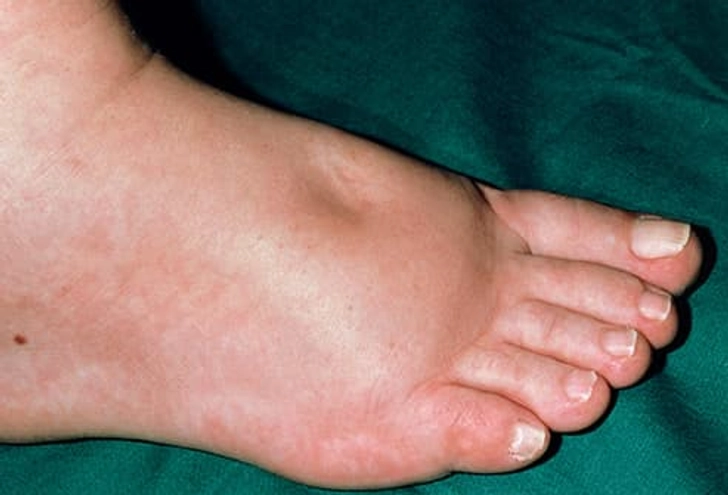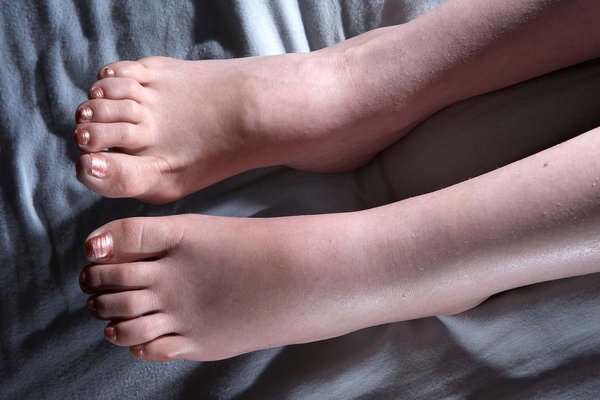
If your feet are swollen, it is a clear sign that… see more
What Is Leg Swelling?
Leg swelling—also known as peripheral edema—is a condition where fluid builds up in the tissues of the lower limbs, causing puffiness, tightness, or discomfort. While it can be harmless in some cases, chronic or sudden swelling may signal an underlying health issue that requires medical attention.
Common Symptoms of Leg Swelling

Some of the most noticeable signs include:
-
Puffy or enlarged legs, ankles, or feet
-
Skin that appears shiny or stretched
-
Indentations left on the skin after removing socks or shoes
-
Difficulty walking or fitting into regular footwear
-
A feeling of heaviness or fatigue in the lower limbs
Swelling may affect one or both legs and often worsens after long periods of sitting, standing, or inactivity.
What Causes Leg Swelling?

-
Prolonged Sitting or Standing
Staying in one position too long can cause fluid to pool in the legs, especially in people with poor circulation. -
Heart Conditions
Congestive heart failure may lead to fluid retention. Swelling with shortness of breath or fatigue can indicate cardiovascular problems. -
Kidney Disorders
When kidneys cannot remove excess fluid and waste properly, swelling in the legs can occur. -
Chronic Venous Insufficiency
If the veins cannot return blood efficiently to the heart, blood may pool in the legs, causing swelling. -
Lymphedema
Blockages or damage in the lymphatic system—often after surgery or cancer treatment—can lead to one-sided swelling. -
Blood Clots (Deep Vein Thrombosis)
A DVT usually causes sudden swelling in one leg, along with pain, redness, or warmth. This is a medical emergency. -
Medications
Drugs such as steroids, calcium channel blockers, antidepressants, and NSAIDs may cause leg swelling. -
Dietary and Lifestyle Factors
-
High-sodium diet → water retention
-
Dehydration → fluid imbalance
-
Lack of activity → poor circulation
-
When to Seek Medical Attention

You should consult a doctor if:
-
Swelling is sudden and painful
-
You have chest pain or shortness of breath
-
The leg is red, warm, or tender
-
Swelling does not improve with rest or elevation
These may point to serious issues such as heart failure, kidney disease, or blood clots.
Diagnosis and Medical Evaluation
/assets/images/provider/photos/2722120.jpg)
Doctors may recommend:
-
Blood tests for kidney and liver function
-
Ultrasound to check for blood clots
-
ECG or echocardiogram for heart health
-
Urinalysis for kidney-related problems
Effective Treatments for Leg Swelling
At-Home Remedies:
-
Elevate legs above heart level for 30 minutes, several times daily
-
Reduce sodium intake
-
Drink more water to flush out excess salt
-
Wear compression socks to improve circulation
-
Stay physically active
Medical Treatments:
-
Diuretics (water pills) to eliminate extra fluid
-
Physical therapy for mobility and lymphatic drainage
-
Treating underlying conditions such as heart or kidney disease
Prevention Tips

-
Move frequently during flights or desk work
-
Avoid crossing your legs for long periods
-
Maintain a healthy weight
-
Exercise regularly
-
Monitor salt intake
Final Thoughts
Leg swelling may seem minor, but it can be a warning sign of more serious health problems. Addressing it early with lifestyle changes, home remedies, or medical treatment can prevent complications. If swelling persists, consult a healthcare professional for proper diagnosis and treatment.
News in the same category


A Cyst on the Foot or Wrist: What You Should Know

These are the signs that he is cr…See moree

7 Things Not to Do Before Taking a Shower to Prevent Stroke – Plus 2 Common Mistakes

10 Warning Signs Your Liver Might Be in Trouble

Lung Cancer Symptoms

Most People Have Had or Have This Cold Sore Virus, But Very Few Know How to Cure It – Here’s What You Need to Do!

These are the signs that he is cr… See more

5 Warning Signs of Breast Cancer That Many Women Ignore

Hibiscus Apple Cinnamon Tea with Lemon – A Delicious Detox Drink for Your Health

Everything You Need to Know About Eating Eggs Daily — Science-Backed Benefits & What to Watch For

25 Amazing Ways to Use Rosemary That Can Change Your Life

All DNA and RNA Bases Found in Meteorites: Life’s Origins May Be Cosmic

Doctor reveals the one thing you should avoid doing if you wake up during the night

Claim: a juice regimen reportedly cleared can:cer cells in 42 days

Top 3 Ways to Treat Tooth Decay with Guava Leaves – Simple and Cost-Effective

8 Signs That Your Body Is Crying for Help

【Surprising】Not Brushing Before Bed VS Not Brushing Before Breakfast – Which Is Worse?

8 Stroke Warning Signs and 9 Tips to Prevent It
News Post

See the Difference: A Delicious Drink to Support Eye Health Naturally

Avocado, Hibiscus & Clove Smoothie: A Vibrant Blend for Energy, Digestion & Glow

Take Honey and Cloves After 50: Fix 13 Common Health Issues in One Week!

A 4-Year-Old Girl Nearly Lost Her Life Due to Diabetes, Parents Cried: “We Spoiled Her Too Much!”

A Cyst on the Foot or Wrist: What You Should Know

Seniors: This Magical Foot Soak Restores Circulation in Just 10 Days!

6 Powerful Juice Recipes to Fight Anemia, Inflammation, Fatigue, Low Immunity, High Cholesterol, and Insomnia

Japanese-Inspired Potato Juice Hair Treatment for Fast, Natural Hair Growth

Lemon Secret for Seniors: Never Mix Lemon With These Three Foods

ROSEMARY WATER FOR HAIR GROWTH:DIY Rosemary Water Recipe & How to Use It for Stronger, Thicker Hair

Old Doctor’s Remedy: Almond Milk with Cloves

Unlocking the Natural Power of Cloves: Simple Home Remedies for Better Health

12 Amazing Beauty Benefits of Lemon: Natural Recipes for Glowing Skin

The Natural Drink Taking 2025 by Storm: May Support Diabetes, Cancer & High Blood Pressure

Amazing! Beauty Hacks Every Girl Should Know – 34 Tips to Grow Your Hair Faster

4 Teas for 4 Organs – and 3 More to Try!

My Secret Hair Growth Formula: Ginger, Rosemary & More for Longer, Healthier Hair

Small but Mighty: The Magic of Clove and Goron Tula Water 🌿💧

The Secret Energy-Boosting Blend Every Man Should Try: Watermelon, Coffee, and More
